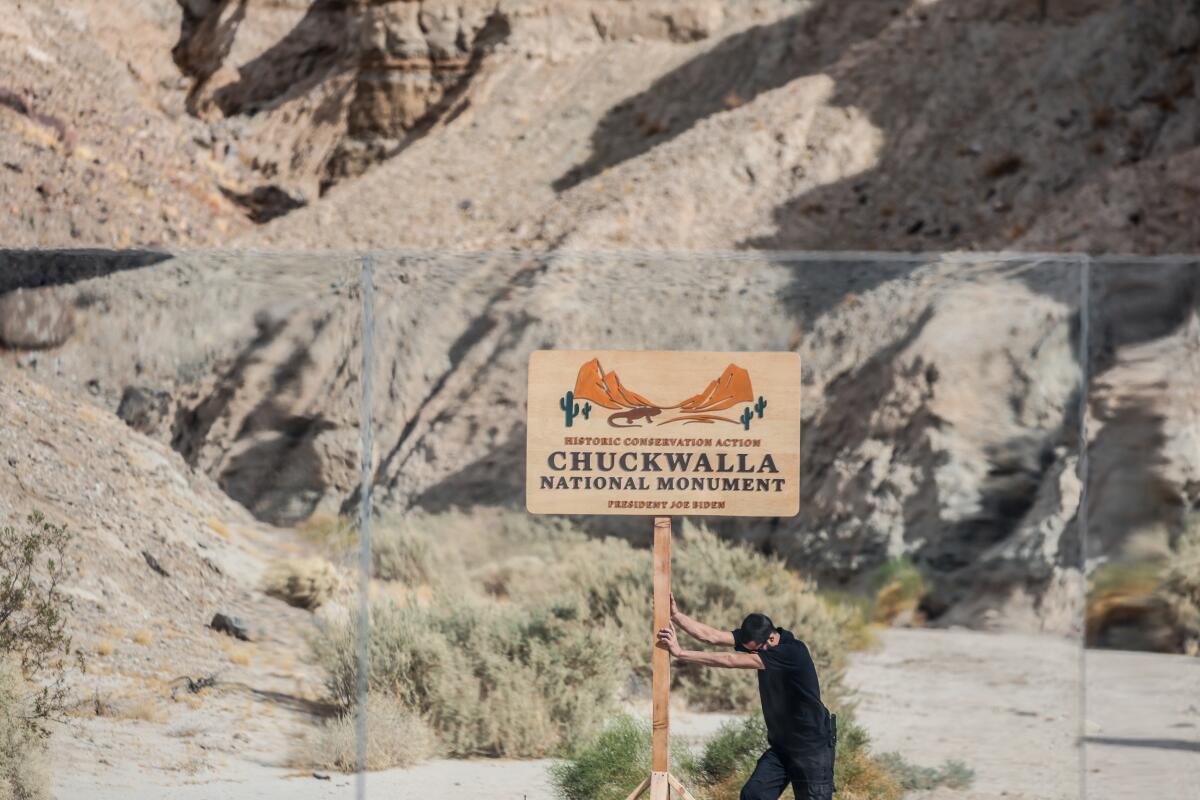Column: Forget Trump’s wrecking ball. Here’s how to treat America’s public lands

- Share via
Russell Scofield remembers when federal officials first started getting applications to build solar farms on public lands. It was the mid-2000s, and he was working for the Bureau of Land Management in Palm Springs. President George W. Bush had signed legislation creating a 30% investment tax credit for large-scale solar projects.
The land rush started fast. Endangered species and sacred Indigenous sites were often unprotected.
Solar applications “just started pouring in,” Scofield said. “Everybody was completely freaked out.”
You're reading Boiling Point
Sammy Roth gets you up to speed on climate change, energy and the environment. Sign up to get it in your inbox twice a week.
You may occasionally receive promotional content from the Los Angeles Times.
He told me this as we trekked through a narrow slot canyon in the Mecca Hills, an hour’s drive southeast of Palm Springs. It’s one of my favorite hikes: a sandy, secluded trail surrounded by exquisitely colored rock walls, formed by the San Andreas fault over millions of years. At various points, creaky metal ladders lean against the rock. They lead up and out of the canyons, to glorious views of Mt. San Jacinto, Mt. San Gorgonio and the Salton Sea.

Solar farms aren’t allowed here. The Mecca Hills have long been a federally protected wilderness area — and now they’re part of a national monument, too. President Biden established Chuckwalla National Monument six days before he left office, at the urging of Native American tribes and conservationists seeking to prevent development on sacred and ecologically sensitive lands.
But the monument might not exist if it weren’t for a deal with the solar industry.
Chuckwalla spans nearly 1,000 square miles, stretching east to the Colorado River and north past the 10 Freeway. At its far northeastern edge, it butts up against one of the nation’s busiest solar development zones, along the 10 near the Arizona state line. As activists campaigned for the monument, they faced questions from government officials about whether protecting these lands could slow or block new solar projects.
Conflicts between conservation and climate-friendly energy have erupted across the Western U.S., threatening to prolong the nation’s addiction to deadly fossil fuels. But this time, the two sides found a solution.
Activists sat down with solar industry representatives and hammered out a compromise. They reduced the size of the proposed monument by about 40,000 acres, giving the solar development zone more breathing room. The changes also gave Southern California Edison more space to build additional power lines alongside Interstate 10, which could carry renewable energy from solar farms toward coastal cities.
By the end of the negotiations, solar developers Clearway Energy and EDF Renewables were publicly supporting the monument proposal, as were several solar industry trade groups — and Edison.
“It wasn’t contentious,” said Garry George, senior director of climate strategy at the nonprofit National Audubon Society. “We wanted to set it as a precedent for clean energy and conservation going together.”
Biden alluded to the deal, most of which he implemented, before signing the monument designation.
“Next door to this monument, solar energy is being built, which proves what I’ve often said — we don’t have to choose between the environment and the economy, or between conservation and clean energy. We can do both at the same time,” Biden said. “This monument offers a perfect road map for how to strike that balance.”

The problem now is that President Trump seems determined to trash both clean energy and conservation.
The conservation part isn’t surprising. During Trump’s first term, his appointees fought to reverse clean air, clean water and endangered species protections. New Interior Secretary Doug Burgum is already implementing the same playbook, issuing orders to ramp up oil and gas leasing, weaken migratory bird protections and consider changes to national monuments boundaries for the sake of increasing fossil fuel production.
Could Chuckwalla be on the chopping block? The Supreme Court has never ruled on whether presidents have the power to eliminate national monuments. But during his first term, Trump tried and failed. He may yet try again.
“I hope for the best, but I prepare for the worst,” California Sen. Alex Padilla said in an interview.
The first Trump administration, to its credit, approved lots of renewable energy projects on public lands, even as it favored planet-warming fossil fuels. This time, Trump’s appointees have already halted all permitting for solar and wind farms. The president’s “energy emergency” order — designed to boost energy production, possibly at the expense of environmental laws — doesn’t include solar and wind on a list of different types of energy.
In a news release, Burgum said the Interior Department is “committed to working collaboratively to unlock America’s full potential in energy dominance and economic development to make life more affordable for every American family.”
There was nothing in the news release about renewable energy or the harms inflicted by climate change — such as the fires that tore through Los Angeles County last month, which scientists say were worsened by fossil fuels.
Leading Democrats are struggling to figure out how to respond.
I asked Padilla, for instance, whether it’s a problem that the Trump administration has stopped permitting solar and wind farms on public lands — and whether Congress should do anything about it. He responded that such projects should be considered on “a case by case basis,” and that “the devil’s always in the details.”
That language would have made sense four months ago, when federal policymakers were focused on threading the needle between clean energy and conservation. With Trump and his cadre of fossil fuel boosters running the federal government, a far more aggressive response is needed to support solar and wind power.

Same goes for conservation. When I asked Padilla about the possibility that Trump will try to undo Chuckwalla, he said he “look[s] forward to chiming in [on] that review process and helping make the case” for the monument.
News flash: Trump doesn’t care what a Democratic senator from California thinks. Safeguarding public lands and the climate will require new political strategies to drum up sustained enthusiasm — not cautious rhetoric.
It wasn’t so long ago that public lands and renewable energy were bipartisan causes.
A few years after President Bush approved the 30% solar tax credit, California Gov. Arnold Schwarzenegger — also a Republican — signed an executive order asking regulators to speed up permitting of solar and wind energy projects.
That led to the Desert Renewable Energy Conservation Plan. Crafted by state and federal officials, it set aside about 400,000 acres of federal lands for renewable energy proposals, and designated some 6.5 million acres for conservation. Scofield, my Mecca Hills hiking partner, helped oversee its implementation.
After the plan was finalized in 2016, Scofield faced the thankless task of balancing clean energy with a wide range of competing interests — not just conservation but also hiking, camping, off-roading, mining and more.
“Nobody was super pleased,” he said.
Even Scofield, who’s retired now, didn’t always relish the work. A self-described “desert rat” who lives near Joshua Tree National Park, he noted that many people consider the solar energy zones “sacrifice areas.”
“This is just me personally — I would like to have seen nothing in the desert. Put it all on rooftops,” he said.
But he also acknowledged that rooftop solar alone can’t replace oil and gas, for technical, economic and political reasons. As we took a break from hiking, standing in a patch of shade along the side of a sandy canyon, he spoke thoughtfully about how public lands belong to, and should benefit, all Americans.
“Oftentimes the greater good is conservation, recreation — the national monument we’re standing in,” he said. “In some cases, the greater good is development of one form or another, whether that’s transmission so you can have electricity in Los Angeles, or whether it’s renewable energy.”

Even as we enjoyed the breathtaking scenery, we were reminded why climate-friendly energy is so badly needed. Scofield pointed out several bright red ocotillo flowers already blooming — a bizarre sight for early February, but very much aligned with other signs of warming. Last month was Earth’s hottest January on record, by a lot.
“Anecdotally, I think you can look around and say spring’s coming earlier,” Scofield said.
Near the end of the trail, we chatted with two hikers just getting started. They were from Mexicali, Mexico, and had no idea they were visiting a new national monument. They thought maybe it was a national park.
International tourism — good for America. Just like renewable energy, healthy lands and a habitable climate. Just like Chuckwalla.
ONE MORE THING

To hear more from my conversation with Russell Scofield, listen to today’s Boiling Point podcast! It’s available on Apple Podcasts, Spotify, YouTube and pretty much anywhere else you might want to listen. Hope you enjoy.
This is the latest edition of Boiling Point, a newsletter about climate change and the environment in the American West. Sign up here to get it in your inbox. And listen to our Boiling Point podcast here.
For more climate and environment news, follow @Sammy_Roth on X and @sammyroth.bsky.social on Bluesky.
Toward a more sustainable California
Get Boiling Point, our newsletter exploring climate change, energy and the environment, and become part of the conversation — and the solution.
You may occasionally receive promotional content from the Los Angeles Times.




